Imagine transforming your home into a sanctuary of clean, fresh air, simply by adding a few thoughtfully chosen plants. Whether you’re a seasoned green thumb or just starting your journey into the world of gardening, the idea of using plants to purify your indoor environment is as appealing as it is practical. Indoor plants not only bring a touch of nature into our living spaces but also work tirelessly behind the scenes to cleanse the air we breathe. Their natural ability to filter out toxins and improve air quality makes them an essential addition to any home.
The importance of clean air in our living spaces cannot be overstated, especially as we spend more time indoors. With this article, you’ll discover how particular plants can enhance your home’s air quality while simultaneously adding a vibrant touch to your decor. From the elegant snake plant to the lush peace lily, we’ll guide you through a selection of plants that are both easy to care for and powerful air purifiers. You’ll learn which plants suit your lifestyle and the specific conditions of your home, empowering you to make informed choices that benefit both your health and happiness.
By the end of this article, you’ll be equipped with practical tips on how to care for these green allies so they can thrive and work their magic. We’ll cover everything from light requirements to watering schedules, ensuring you have all the tools you need to succeed, no matter your level of gardening expertise. Whether you’re looking to enhance your home office with a touch of greenery or want to create a healthier environment for your family, these air-purifying plants offer a simple, effective solution. Let’s dive into this green world and uncover the many ways plants can refresh your space and uplift your spirit.
Understanding Air-Purifying Plants
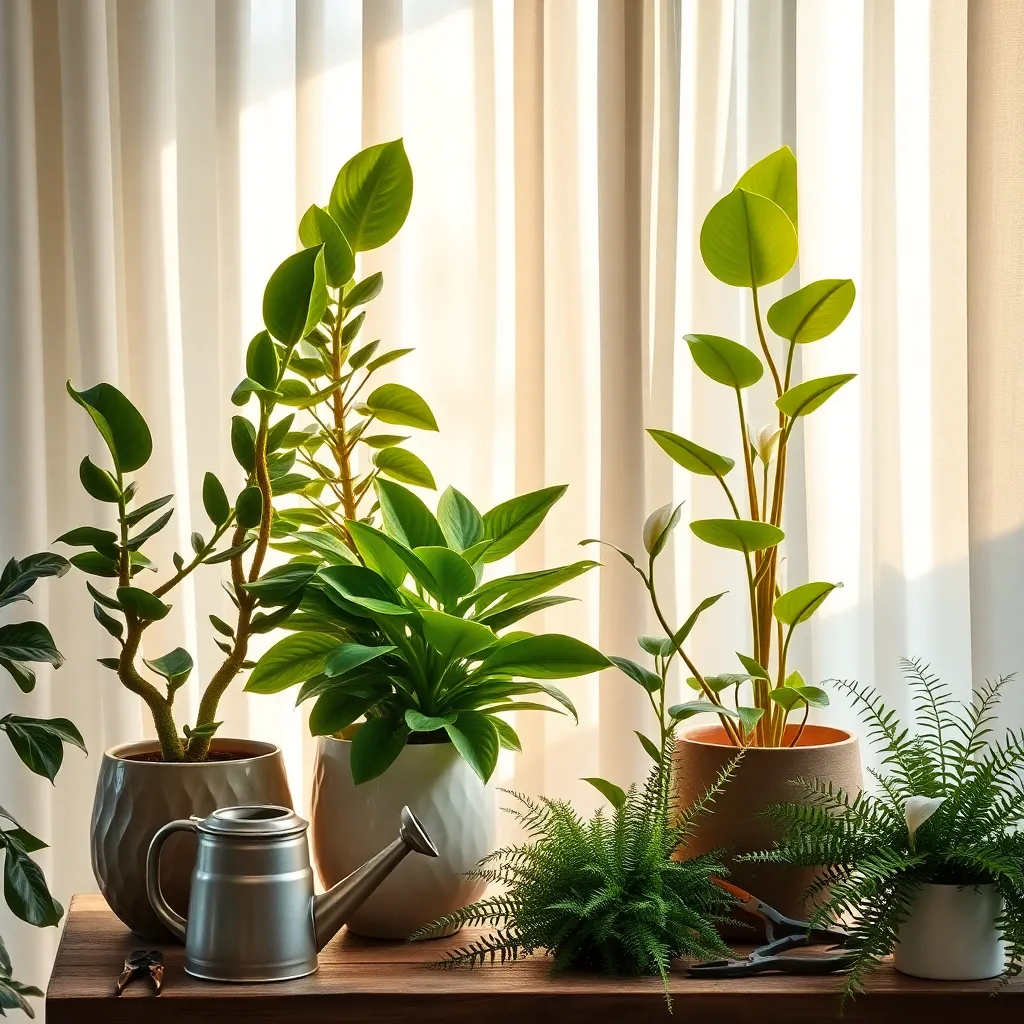
Air-purifying plants are a fantastic way to improve the quality of the air in your home while also adding a touch of nature to your space. These plants are known to filter out toxins from the air, making your indoor environment healthier and more pleasant.
One popular choice for air purification is the Peace Lily, which thrives in low-light conditions and requires minimal care. To keep your Peace Lily healthy, water it once a week and ensure the soil remains consistently moist but not soggy.
For those looking for a low-maintenance option, the Snake Plant is ideal, as it can tolerate a range of lighting conditions and infrequent watering. Place your Snake Plant in a well-draining soil mix and water only when the top inch of soil is dry to the touch.
Consider adding a Boston Fern to your collection, especially if you want to tackle humidity levels in your home. This plant prefers indirect light and high humidity, so misting it regularly or placing it near a humidifier can help it thrive.
When caring for air-purifying plants, it’s critical to keep an eye on their leaves for signs of distress such as browning tips or yellowing. Adjust watering and light conditions as necessary, and don’t forget to dust the leaves occasionally to keep them free from dust, allowing for optimal air purification.
Top Indoor Plants for Clean Air
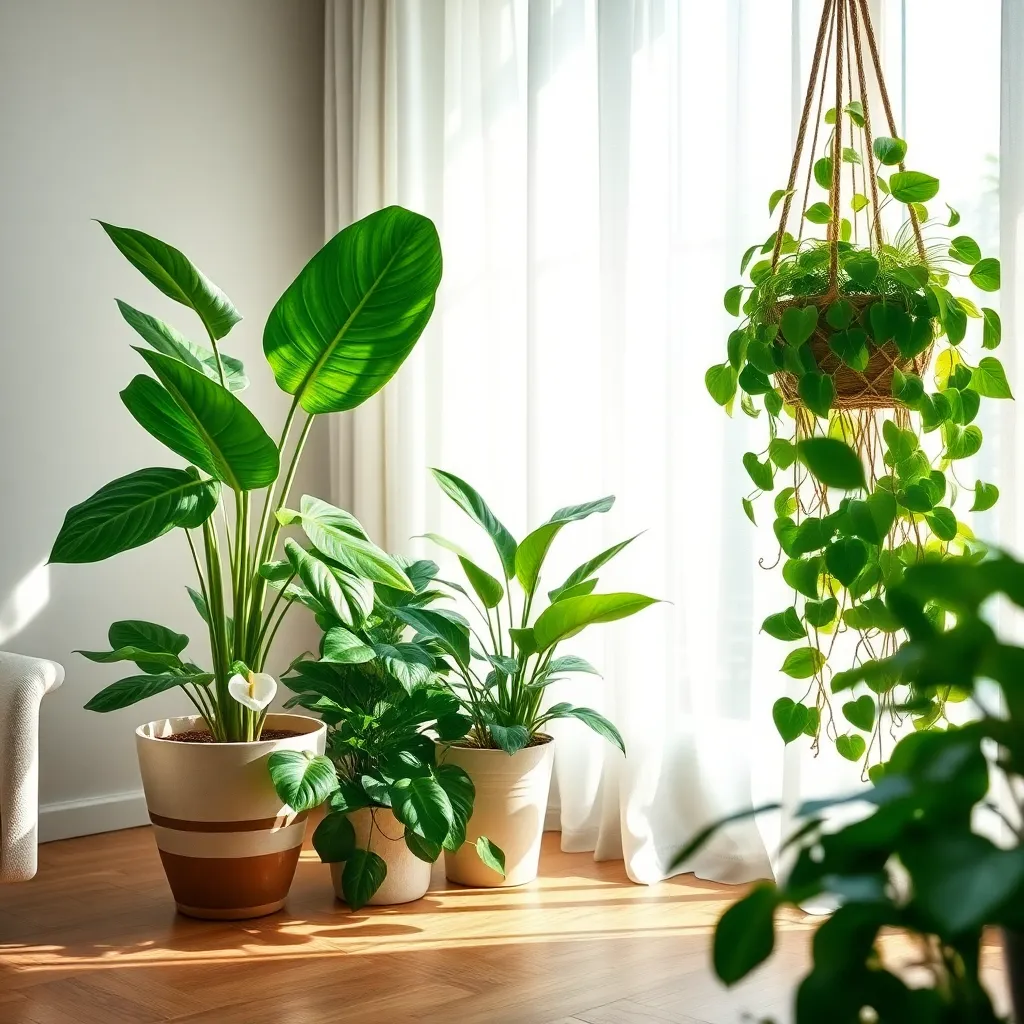
One of the top choices for air purification in your home is the Spider Plant. Known for its hardiness, it thrives in indirect sunlight and needs watering only when the top inch of soil feels dry.
Besides its air-cleaning abilities, the Peace Lily is admired for its elegant white blooms. This plant prefers low-light conditions and should be kept in well-draining soil, with watering done once the soil surface starts to dry out.
Another excellent option is the Snake Plant, also known as Mother-in-Law’s Tongue. It requires minimal care, making it ideal for beginners; simply place it in moderate light and water it every couple of weeks.
For those looking to add a splash of color, consider the Rubber Plant. It not only purifies the air but also thrives in bright, indirect light and requires a moist but not soggy soil environment.
To ensure successful growth of these plants, use a light, well-draining potting mix to prevent root rot. Fertilize them with a balanced houseplant fertilizer every month during the growing season to enhance their air-purifying capabilities.
Advanced gardeners might experiment with humidity levels, as some of these plants, like the Peace Lily, benefit from a slightly more humid environment. Using a tray of pebbles and water under the pot can help maintain the necessary humidity levels.
Caring for Your Air-Cleaning Plants
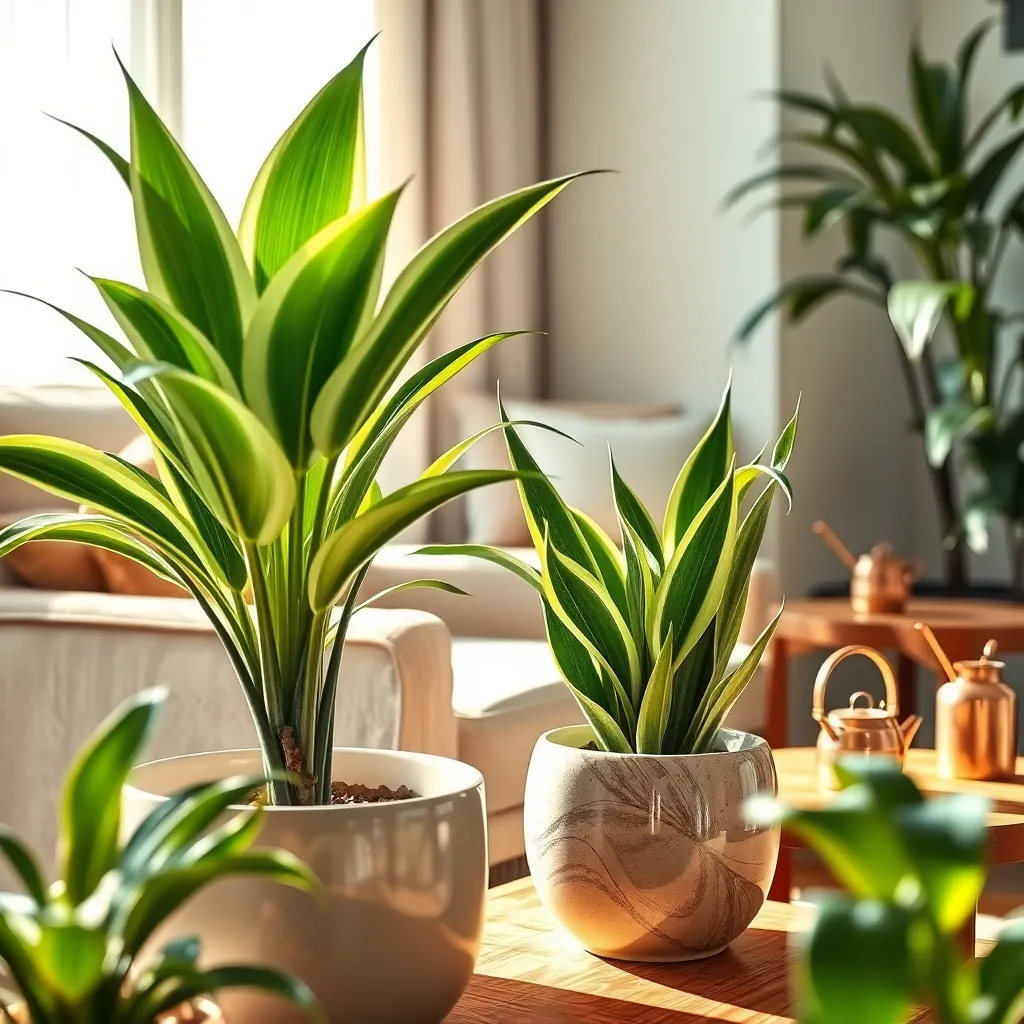
To ensure your air-cleaning plants thrive, it’s essential to provide them with the right growing conditions. Most of these plants prefer indirect sunlight, so placing them near a window with filtered light is ideal.
Regular watering is crucial, but it’s important to avoid overwatering. Check the soil moisture by sticking your finger about an inch deep; if it feels dry, it’s time to water.
For optimal growth, use a high-quality potting mix that offers good drainage. A mix with peat moss, perlite, and vermiculite helps prevent root rot by ensuring excess water drains away quickly.
Fertilizing your plants can greatly enhance their ability to clean the air. Use a balanced liquid fertilizer every month during the growing season to provide essential nutrients.
Advanced gardeners might consider repotting every couple of years to refresh the soil and allow the roots more space. When repotting, choose a container that’s only slightly larger to prevent excessive water retention and promote healthy root growth.
Maximizing Air Purification Benefits
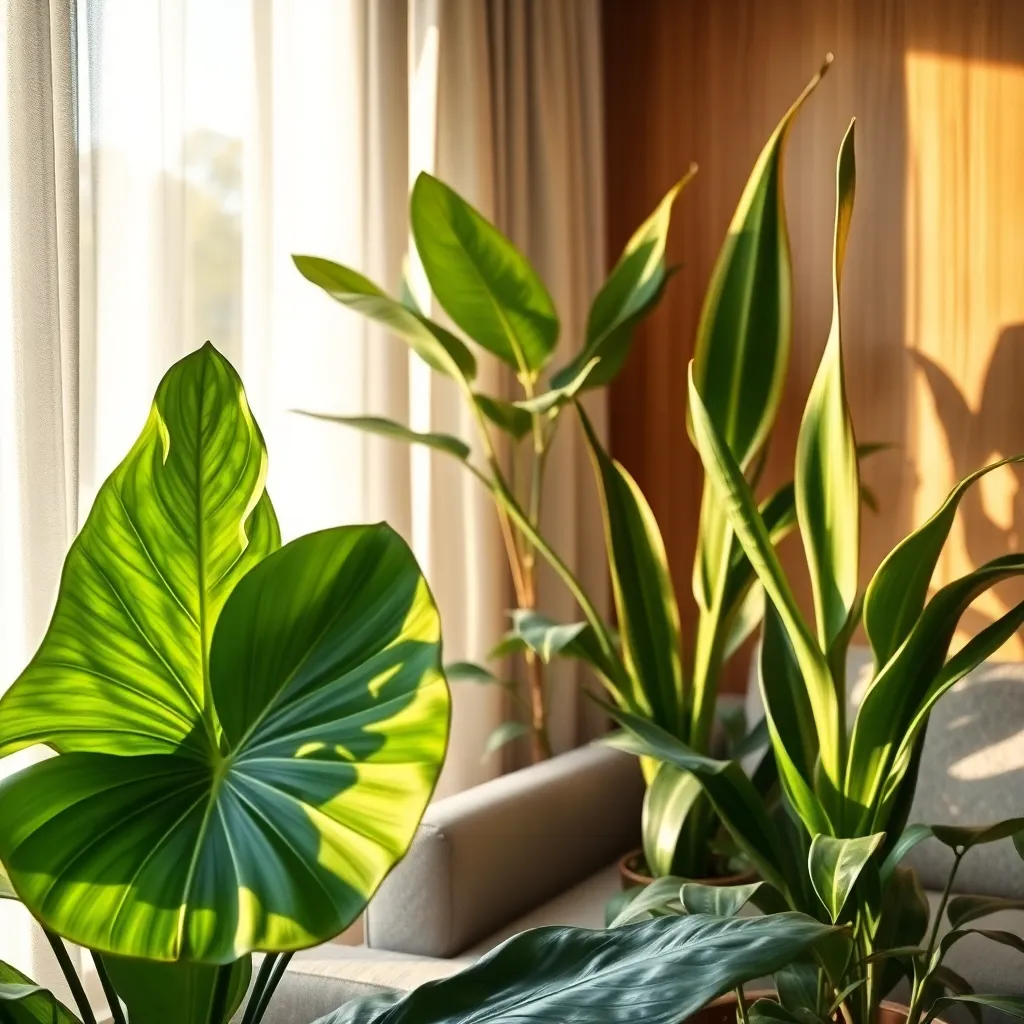
To maximize air purification benefits from your plants, consider the placement within your home. Position plants like the Snake Plant and Peace Lily in areas with good light access, such as near windows, to enhance their natural ability to filter air.
Regular maintenance is key, so ensure you dust plant leaves gently with a damp cloth to keep their surfaces free of dust and grime. This practice improves their photosynthesis efficiency, enabling them to absorb more pollutants from the air.
Watering frequency should match each plant’s specific needs; for instance, the Boston Fern thrives with consistently moist soil, while the Spider Plant prefers to dry out slightly between waterings. Use a well-draining potting mix, such as one enriched with perlite or orchid bark, to provide optimal conditions for air-cleaning plants.
For advanced gardeners, consider implementing a routine of rotating your plants between rooms every few weeks. This not only provides a change of air quality exposure for the plants but also ensures all areas of your home benefit from cleaner air over time.
Common Mistakes to Avoid
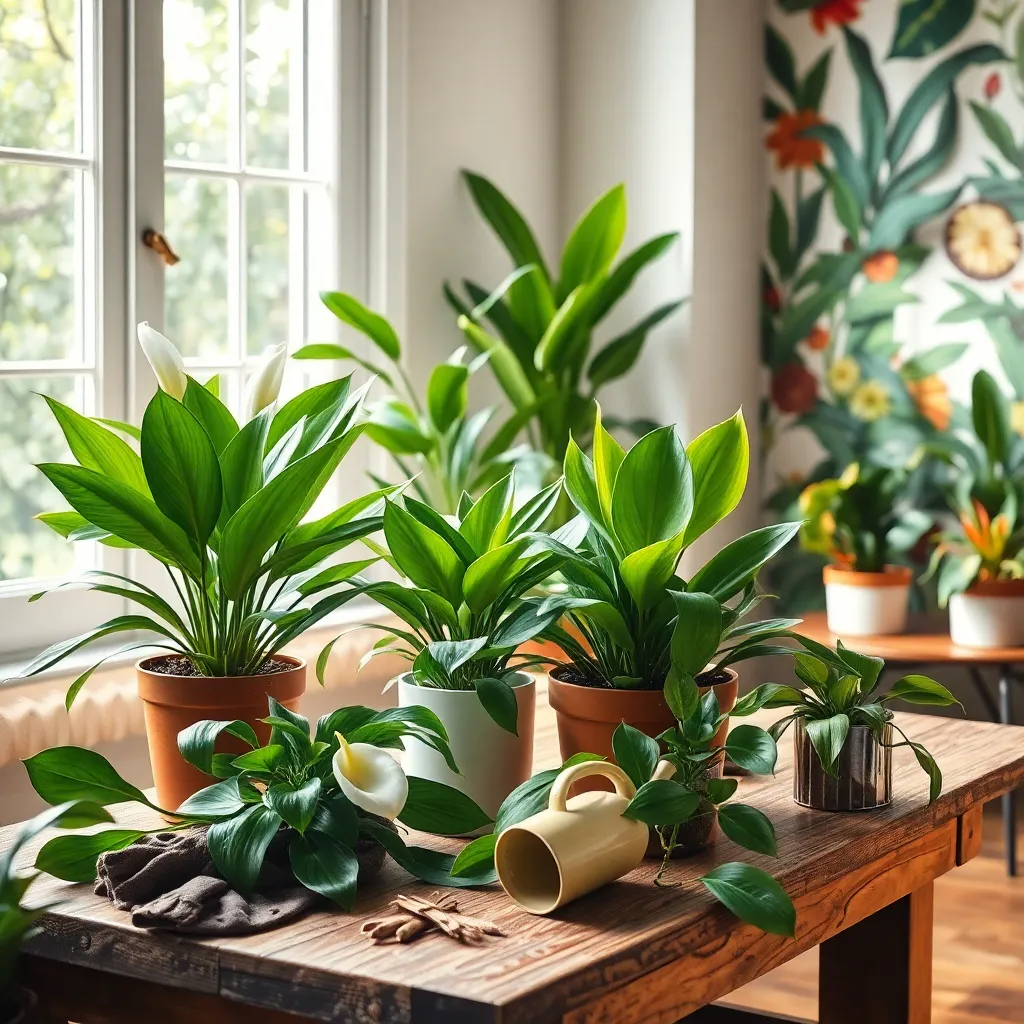
Many gardeners inadvertently neglect the importance of proper lighting conditions for their air-purifying plants. Each plant species has its own specific light requirements, and placing them in the wrong spot can hinder their ability to clean the air effectively.
Overwatering is another common mistake that can be detrimental to your air-purifying plants. To prevent root rot, ensure you use a well-draining soil mix, and only water when the top inch of soil feels dry to the touch.
Some gardeners overlook the necessity of regularly cleaning leaves to maximize air purification. Dust and dirt accumulation can block stomata, reducing the plant’s ability to absorb carbon dioxide and release oxygen.
Failing to repot your plants as they grow can limit their air-cleaning efficiency. Most indoor plants benefit from being repotted every one to two years to refresh soil nutrients and provide adequate space for root expansion.
- For beginners, start with resilient plants like pothos or spider plants that can thrive in a range of conditions.
- Experienced gardeners might experiment with more finicky species like the peace lily, which requires consistently moist soil and indirect light.
Ignoring pest control can also be a mistake that harms your plant’s health. Regularly inspect your plants for signs of pests such as spider mites or aphids, and treat any infestations promptly with gentle, plant-safe solutions.
Another error is neglecting seasonal adjustments in care routines. As seasons change, you may need to adjust watering schedules, light exposure, and nutrient applications to align with your plant’s natural growth cycles.
Conclusion: Growing Success with These Plants
In exploring ‘Plants That Clean the Air in Your Home,’ we’ve delved into five key relationship-enhancing concepts: creating a nurturing environment, fostering growth together, the importance of mutual care, the role of natural elements in promoting well-being, and the power of small, consistent actions in strengthening bonds. These elements highlight how simple, intentional choices can transform both your physical and relational spaces into havens of health and happiness.
To put these insights into action, consider introducing a new plant into your living space this week. Not only will this step purify your air, but it will also serve as a daily reminder of the love and care you wish to cultivate in your relationships. As you embark on this journey of growth, be sure to save or bookmark this article. It’s a resource designed to guide you through nurturing connections that thrive.
Looking ahead, remember that the seeds of relationship success are sown in everyday moments of attention and care. With each small step, you’re on a path to creating lasting bonds that will flourish over time. Let this article be your companion in building a future filled with love and vitality.
